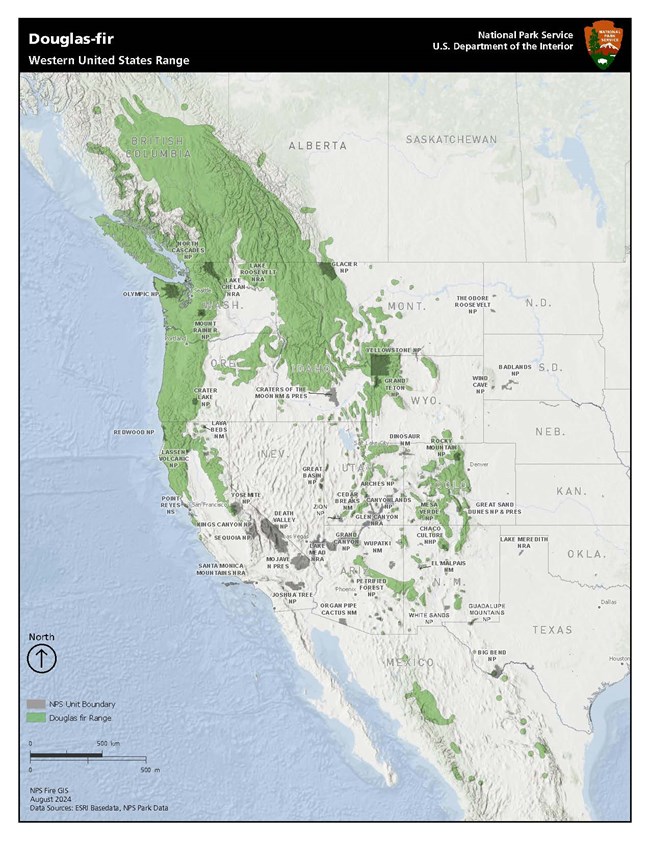Last updated: March 4, 2025
Article
Wildland Fire in Douglas Fir: Western United States

NPS/K. LOVING
Douglas-fir is widely distributed throughout the western United States as well as southern British Columbia, Canada and into portions of Mexico.
This forest type may be found climates where precipitation exceeds 50 inches annually and is generally found among other tree species. Depending on the area, principle trees associated with Douglas-fir are western hemlock, silver, noble and grand firs, and western red cedar. In California, they are found in association with white and red firs in addition to other tree species.

NPS
Douglas-fir is able to survive without fire. Additionally, older Douglas-fir trees have thick bark that enable the species to withstand low to medium intensity fire, however, high intensity fire may kill a Douglas-fir of any age. The Douglas-fir’s abundantly produced seeds are lightweight and winged, allowing the wind to carry them to new locations where seedlings can be established.
Douglas-fir regenerates following fire, but the species does not regenerate well in the shade of an established forest, whereas other species that grow near Douglas-firs, such as western hemlock, do regenerate well in the shade. Thus, an old Douglas-fir forest may have old trees that are mostly Douglas-fir and young trees that are mostly western hemlock. A forest may begin as primarily Douglas-fir, but as it grows older and the Douglas-fir die, they are replaced by western hemlock, until the next high intensity fire opens up the forest for Douglas-fir seedlings. Thus low intensity fire allows the current forest composition or make-up to continue, while over hundreds of years, Douglas-fir is slowly replaced with western hemlock. If there is a severe crown fire, the forest is cleared and can be restarted with new young Douglas-fir seedlings.
Another benefit of fire in these Douglas-fir forest communities is that it kills fungus. As forests age, there may be a slow increase in root rot as fungi travel from tree to tree. This is a natural process and the fungi are native species. When the fungus rots the trees' roots, the tree falls over. Fire may sterilize the soil, killing the fungus.
Because Douglas-fir grows with other types of trees, the implementation of prescribed fire in this type of forest community must consider the life cycles of many species.
Tags
- bandelier national monument
- bighorn canyon national recreation area
- black canyon of the gunnison national park
- bryce canyon national park
- canyonlands national park
- capitol reef national park
- capulin volcano national monument
- carlsbad caverns national park
- cedar breaks national monument
- chiricahua national monument
- city of rocks national reserve
- crater lake national park
- craters of the moon national monument & preserve
- curecanti national recreation area
- el malpais national monument
- florissant fossil beds national monument
- gila cliff dwellings national monument
- glacier national park
- golden gate national recreation area
- grand canyon national park
- grand teton national park
- great basin national park
- great sand dunes national park & preserve
- lake roosevelt national recreation area
- lassen volcanic national park
- mesa verde national park
- mount rainier national park
- north cascades national park
- olympic national park
- oregon caves national monument & preserve
- point reyes national seashore
- redwood national and state parks
- saguaro national park
- san juan island national historical park
- sunset crater volcano national monument
- valles caldera national preserve
- walnut canyon national monument
- whiskeytown national recreation area
- yellowstone national park
- yosemite national park
- zion national park
- douglas fir
- wildland fire
- washington
- oregon
- idaho
- montana
- wyoming
- colorado
- utah
- arizona
- new mexico
- nevada
- california
- learning in depth
- fire facts
- fire in ecosystems
- fire ecology
- jmrlc
- natural resources
- fire
- forestry
